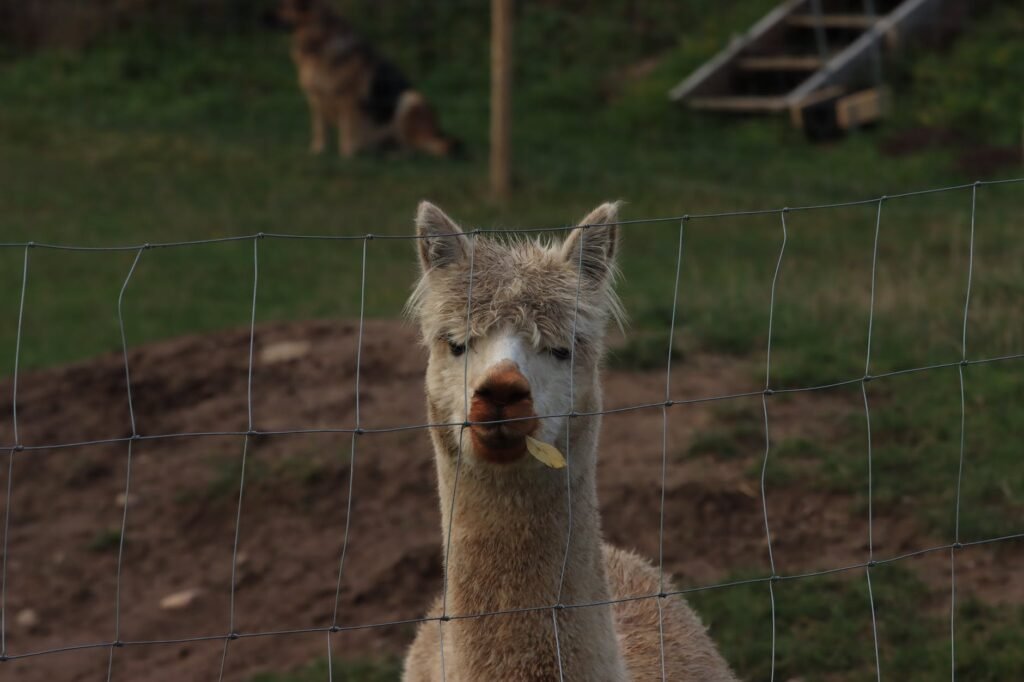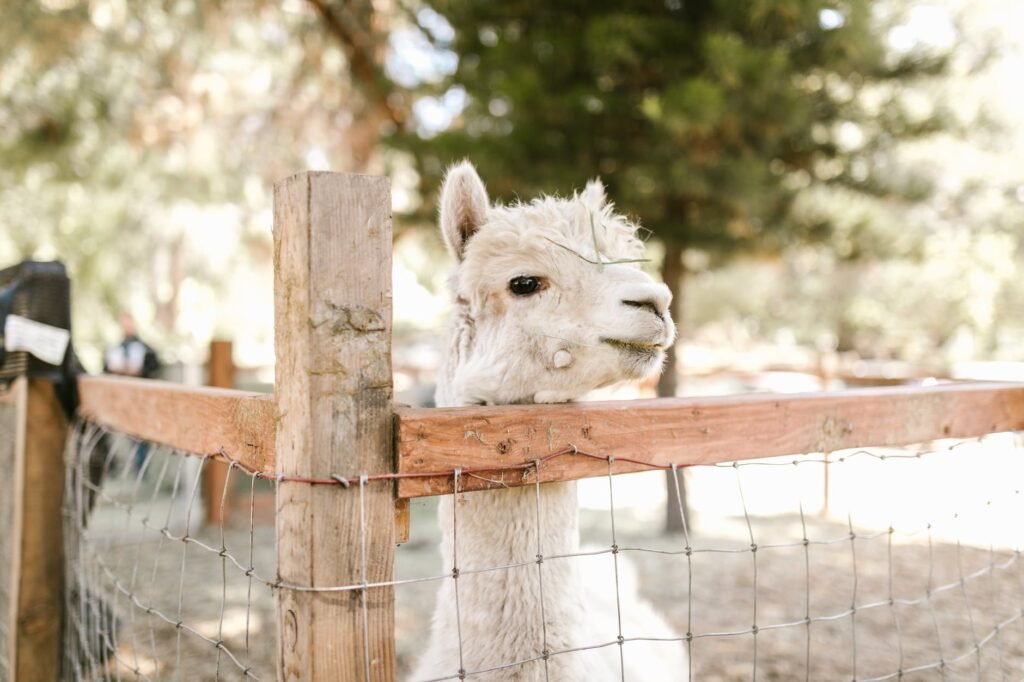Do Alpacas Have Horns and Why Not?
Ever wondered if alpacas have horns? I’ve been there too! As a seasoned animal enthusiast, I’ve spent countless hours researching various animal species and their unique characteristics. And today, I’ll be sharing my findings about these fascinating creatures.
Alpacas, known for their adorable faces and fluffy coats, are a topic of interest for many. Their physical attributes often spark curiosity, particularly the question: “Do alpacas have horns?” This question is more common than you might think, and it’s one I’m excited to delve into.
Key Takeaways
- Alpacas, despite common misconceptions, do not have horns. This prevalent myth likely stems from their association with other larger camelids, like llamas, which do possess horns.
- The absence of horns on alpacas makes them more approachable and safe for human interaction, making them excellent companions, especially for children and seniors.
- Contrary to many mammalian species, alpacas utilize different mechanisms for defense and dominance establishment. Instead of horns, they possess sharp fighting teeth, primarily in males, and resort to fast movements to evade threats.
- Alpacas’ unique physical attributes such as large, expressive eyes with excellent peripheral vision and spear-shaped ears that can swivel 360 degrees, play a crucial role in their survival.
- The lack of horns in alpacas is an evolutionary advantage rather than a disadvantage. It reduces their weight, enhances speed and endurance, and emphasizes their other unique survival techniques.
- Alpacas significantly contrast with horned ungulates like sheep and goats. Apart from the obvious difference of lacking horns, alpacas rely on their agility, sharp teeth, and strong sensory abilities for survival, whereas horned animals primarily depend on their horns as a defense mechanism.
Alpacas: The Magical Creatures with Fluffy Coats
Consider your first time laying eyes on an alpaca. Did those adorably big eyes lure you in? Or was it their amusing facial expression? For me, it was their fluffy coat that never failed to spark my curiosity. Over time, I’ve discovered there’s more to it than its enchanting appearance.

Originating from South America, alpacas are often mistaken for llamas due to their uncanny resemblance. Although they share the same family tree, they are two separate species. An important fact is alpacas are much smaller than llamas. They have kinder and friendlier demeanors, making them excellent companions for children and seniors alike.
Let’s talk about alpacas’ most charming feature – their fluffy coat! It’s not only about aesthetics; their coat is their key survival tool. Unlike any ordinary wool, it’s luxurious, hypoallergenic, and can regulate temperature. Traditional communities have been harvesting their wool for centuries to create warm clothing and materials.

However, underneath all that fluff, don’t expect to find any horns. Alpacas are naturally hornless creatures. Their charming, goofy faces are free of any sharp protrusions. This is quite opposite to other domesticated mammals like goats or cows.
Speaking of their faces, one could argue it’s the alpacas’ next best feature! They win our affection with their wide eyes and long eyelashes. Shyness is a common trait among these species, so you’ll often witness their quirky habit of greeting you with a surprise spit.

Unlocking the mystery behind alpacas and their absence of horns made me even more intrigued to explore further. Aren’t they truly amazing? Alpacas, with their unique attributes, are undeniably worthy of fascination and intrigue. Let’s dig deeper and marvel at the other charming features they have to offer.
Debunking the Myth: Alpacas and Horns
On the outset, I’d like to set the record straight. Alpacas do not, in fact, have horns. This common misconception likely stems from their association with other larger camelids, such as llamas, which do possess these intimidating features. Allow me to delve deeper into this riveting subject.
Have you ever carefully observed the heads of alpacas? You’ll find no trace of horns. Instead, they boast a pair of adorable, oversized ears sticking out from their fluffy heads. This is one of the integral features differentiating alpacas from their llama cousins, who sport curved, banana-shaped ears. Additionally, a lack of horns makes the alpacas more approachable and safe for human handling especially for children and seniors.
The absence of horns on alpacas may seem surprising to some, primarily because horns often serve vital functions for many mammalian species. Defensive tactics, courtship rituals, and head-on battles for dominance — all commonly facilitated by these formidable appendages.
So, the absence of horns raises an intriguing question: How do alpacas assert dominance or defend from potential threats? Alpacas are not devoid of defensive capabilities. When threatened, they spit – similar to llamas – as a form of self-defense. Furthermore, their speed can also be employed as a survival tool when fleeing from predators.
| Factor | Alpaca | Llama |
|---|---|---|
| Horns | None | Yes |
| Ears | Oversized, round | Curved, banana-shaped |
My exploration of the alpaca’s horn-less head not only debunks a prevalent myth but also deepens my understanding of this delightful species. Stay tuned as I’ll continue examining other aspects of alpaca biology in forthcoming sections.
The Anatomy of Alpacas: Understanding Their Physical Features
You’re likely curious about more than just the question, “Do alpacas have horns?” Well, I’ve got good news for you: there’s much more to explore. Delving into the features of the anatomy of alpacas is like reading an intriguing book – never failing to surprise you.
Let’s start with their feet. Unlike their hoofed counterparts, alpacas have two toes, much like a camel. Their feet comprise a soft pad and two toenails that curve downward. This setup equips them to navigate rocky terrains with little to no impact on the ecosystem.
Let’s talk about their teeth. Males, in particular, possess sharp, pointy teeth known as fighting teeth. Far from being just for show, these teeth come into play during conflicts, ostensibly to establish dominance.
| Gender | Description | Usage |
|---|---|---|
| Male | Sharp teeth | Establish dominance |
Moving on to the head, the ears offer yet another interesting insight into the world of alpacas. Designed in a spear-shaped fashion, they can swivel 360 degrees, enhancing their hearing ability dramatically. This means nothing much gets past an alpaca!
On their face, you’ll find two big, expressive eyes, adapted for excellent peripheral vision. This characteristic helps these creatures stay alert and aware of the surroundings – a boon in the wild.
So now you’re aware, alpacas do not sport horns. Yet, their physical features are myriad and fascinating, each serving a unique purpose. From their feet and teeth to ears and eyes, each plays a significant role in an alpaca’s life. Keep exploring with me as we journey deeper into the intriguing world of alpacas.
The Evolutionary Advantage: Why Alpacas Don’t Have Horns
It’s commonly wondered why alpacas don’t have horns. To answer this, let’s delve into the evolutionary advantages that alpacas gained without them. Their unique physical characteristics like speed, agility, teeth, ears, and eyes for defense, and lack of horns offer more advantages than one might initially consider.
Alpacas compensate for lack of horns with their fast pace and agility. It’s worth noting that in the wild, an alpaca’s primary defense against predators is escape. Their long legs and swift movements make it easier for them to outrun potential threats. Being hornless also reduces their weight, thus enhancing their speed and endurance, crucial for survival in the wild.
Alpacas have developed sharp fighting teeth. For close encounters with predators or when establishing dominance within the herd, these teeth are their primary weapon, taking the place of horns other animals commonly use for such purposes. Unlike horns which are a universal tool for defense and dominance, the usage of teeth emphasizes the agility and speed of alpacas.
Their ears and eyes serve an invaluable role in survival. Alpacas’ ears can swivel 360 degrees, enhancing their sensory perception of the surroundings. Their eyes provide them excellent peripheral vision, allowing them to spot predators or danger from afar. This early detection system gives alpacas a heads-up, allowing time to seek shelter or escape the threat.
The absence of horns in alpacas isn’t a disadvantage at all. It’s an evolutionary step forward. It highlights how nature adapts, using different survival techniques to thrive in various environments. The nimble, agile, and keen alpaca offers an intriguing look into this process. My fascination and admiration for these creatures continue to grow.
The Difference Between Alpacas and Their Horned Counterparts
Let’s dive into the differences between alpacas and their horned counterparts such as sheep, goats, and other ungulates (hoofed mammals). The most apparent distinction is the lack of horns in alpacas — a trait which has its own set of evolutionary advantages.
While both horned ungulates and alpacas utilize their unique adaptations for survival, their strategies differ vastly. The key differences lie in their defensive strategies, agility, and sensory abilities. In place of horns, alpacas depend upon their speed, sharp fighting teeth, excellent peripheral vision, and 360-degree ear movement.

Horned animals rely on their strong, sharp horns as their primary defense mechanism, often butting heads to establish dominance within their groups. The sharper and larger the horn, the greater the chance the animal has of dominating others. With alpacas, however, it’s a different game altogether. They rely on their sharp teeth and quick, agile movement to deter threats and maintain control within their herds.
Another contrasting feature is their sensory abilities. Horned animals can be handicapped by limited vision due to their horn structure, whereas alpacas boast an outstanding peripheral vision and are quick to respond to potential threats. Their ears function similarly, able to swivel a complete 360 degrees, effectively extending their sensory range.
An interesting comparison comes when we look at the energy consumption of these animals. Horns consume a significant amount of an animal’s energy during their growth, an expenditure alpacas do not have to worry about. This not only eliminates a drain on their energy but also frees them up for more efficient use of resources.
In this light, it’s clear to see alpacas’ lack of horns is not a disadvantage but a testament to their adaptive evolution. They demonstrate the sheer variety and flexibility of survival strategies within the animal kingdom. The absence of horns in alpacas is a fascinating example of how nature finds creative solutions to ensure the survival of a species. It is this versatility that lends to my ever-growing admiration of these incredible animals.








Our picks
Alpaca & Wool Felted Sole Inserts: Comfy Upgrade?
Best Alpaca Socks for Hiking: Ultimate Comfort and Durability on Trails
Best Alpaca Halter for Comfort and Control